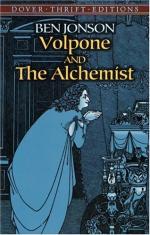|
This section contains 303 words (approx. 1 page at 400 words per page) |

|
The Alchemist Summary & Study Guide Description
The Alchemist Summary & Study Guide includes comprehensive information and analysis to help you understand the book. This study guide contains the following sections:
This detailed literature summary also contains Bibliography on The Alchemist by Ben Jonson.
The Alchemist is one of Ben Jonson' s more popular comedies. Cony-catching or swindling (a cony was another word for dupe, gull, or victim) was as popular in the seventeenth century as it is in the twentieth. The con or swindle was a familiar theme and one which Jonson found to be a natural topic for comedy. There is little known about audience reaction to any of Jonson's plays. There were no theatre reviews and no newspapers or magazines to report on the opening of a play. The little that is known is drawn from surviving letters and diaries. But Jonson was not as popular with theatre-goers as William Shakespeare. In general, Jonson's plays were not well received by audiences, but The Alchemist appears to have been more popular than most, probably because of its topic.
Jonson differed from other playwrights of his period iq, that he did not use old stories, fables, or histories as the sources for his plays. Instead, Jonson used a plot "type" as the basis for most of his drama. In The Alchemist the plot is the familiar one of a farce. The characters are common, a man or men and a woman who set up the swindle. The victims offer a selection of London society. Like the characters from Geoffrey Chaucer's Canterbury Tales, there are religious men, a clerk and a shopkeeper, a widow, a knight, and a foolish young man. Jonson's characters are not well-defined, nor do they have any depth. Instead, they are "types" familiar to the audience. The initial popularity of The Alchemist diminished in subsequent years; by BEN(JAMIN) JONSON 1610 the eighteenth century the play was rarely being produced. As is the case with most of Jonson's plays, The Alchemist has been rarely produced outside of England during the twentieth century.
Read more from the Study Guide
|
This section contains 303 words (approx. 1 page at 400 words per page) |

|



